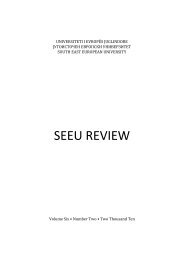SEEU Review vol. 5 Nr. 2 (pdf) - South East European University
SEEU Review vol. 5 Nr. 2 (pdf) - South East European University
SEEU Review vol. 5 Nr. 2 (pdf) - South East European University
Create successful ePaper yourself
Turn your PDF publications into a flip-book with our unique Google optimized e-Paper software.
<strong>SEEU</strong> <strong>Review</strong> Volume 5, No. 2, 2009<br />
Due to this, the sustainable development can be characterized as a sui<br />
generis balance between the economic development and the environment.<br />
But, this does not explain and absorb the whole concept of sustainable<br />
development. It also means integrating social, economic and environment<br />
issues altogether. According to many authors, the economic and social<br />
policy as well as the policy on the environmental policy, are the three pillars<br />
of the sustainable development, which should not be understood as sufficient<br />
in order to determine the concept of sustainable development; a lot of other<br />
spheres should be taken into consideration to get closer to the concept we are<br />
discussing about. Those areas will be explain later in this paper. Some of<br />
the definitions of the sustainable development relate it to the moderate use of<br />
natural resources, and in this respect it is seen as a development that tends to<br />
build strategies which will enable economic and social development that<br />
avoids the effusive exploitation of natural resources and will not harm the<br />
environment itself.<br />
Similar to this is the definition by which the sustainable development is<br />
determined as management of natural resources which enables their<br />
sustainability. Other authors point out that sustainable development is a<br />
dynamic category in which economic, social and ecological components are<br />
integrated and which represent only the basic components, because the<br />
sustainable development has other components too, which are oriented<br />
towards better education, development of renewable energy sources and<br />
rational and sustainable use of energy, reduction of wastes, technological<br />
and scientific development, reduction of poverty, improvement of quality of<br />
life and sufficient amount of food for people (which is quite worrying having<br />
into consideration that more than 900 million people in the world are facing<br />
the permanent famine and lack of food), reduction of negative effects from<br />
climate changes, especially droughts, as well as other aims that come out of<br />
these basic objectives. For some authors, the downfall of sustainable<br />
development is the most crucial that humanity is facing nowadays. Along<br />
this line there are even more radical claims that sustainable development has<br />
to offer solutions for saving the world, especially through fighting the<br />
negative effects from climate changes and development of renewable energy<br />
and application of new clean technologies which will reduce these negative<br />
effects. These were only a part of conceptual definitions of the sustainable<br />
development, given by eminent world authorities, which only verifies the<br />
complexity of the definition of the concept of sustainable development. This<br />
is quite understandable having in mind the <strong>vol</strong>ume and actuality of the<br />
concept of sustainable development.<br />
113

















